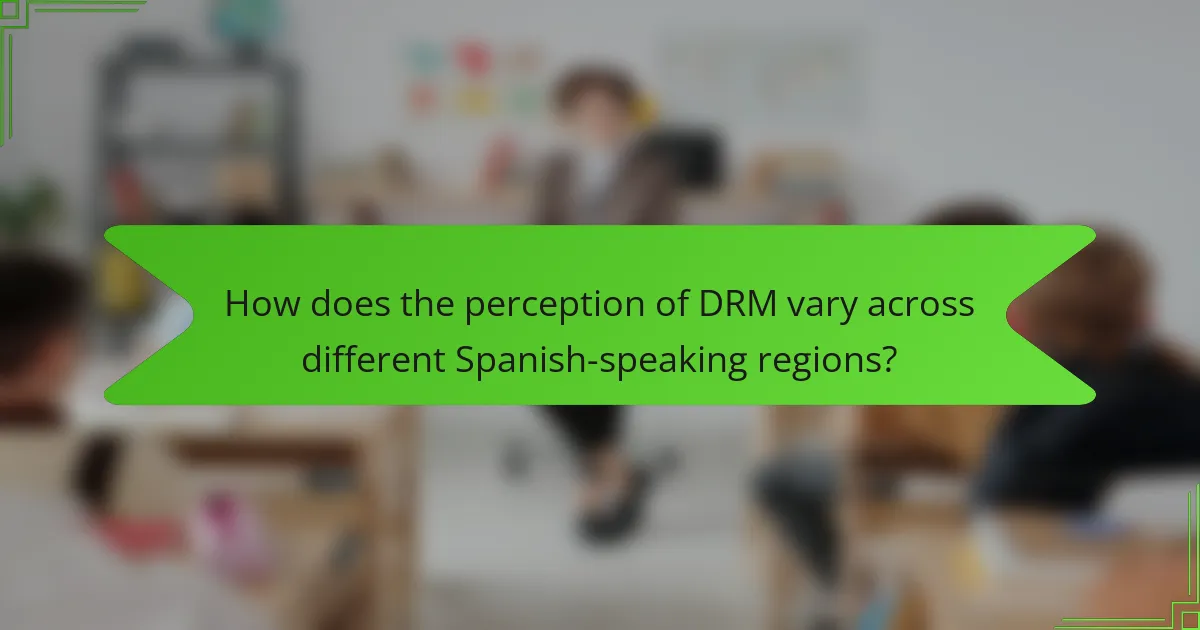Digital Rights Management (DRM) in Spanish publishing faces significant challenges, including copyright infringement and user resistance. Innovative solutions like blockchain and adaptive licensing are being explored to enhance effectiveness. Regional perceptions of DRM vary, influencing its acceptance and implementation. Future directions may involve flexible approaches that balance rights protection with user accessibility.

What are the main challenges of Digital Rights Management in Spanish publishing?
The main challenges of Digital Rights Management in Spanish publishing include copyright infringement, technological barriers, and user resistance. Copyright infringement undermines content protection, while technological barriers complicate implementation. User resistance arises from perceived restrictions on access and usability. Addressing these challenges requires innovative solutions and collaboration among stakeholders.
How do piracy and copyright infringement impact the industry?
Piracy and copyright infringement significantly harm the publishing industry by reducing revenue and undermining authors’ rights. The prevalence of digital piracy leads to financial losses that can exceed billions annually. Additionally, copyright infringement complicates the enforcement of digital rights management, making it challenging for publishers to protect their intellectual property. As a result, the industry must innovate solutions, such as enhanced DRM technologies and legal frameworks, to combat these issues effectively.
What are the technological barriers to effective DRM implementation?
Technological barriers to effective Digital Rights Management (DRM) implementation include compatibility issues, high costs, and user resistance. These challenges hinder the adoption of DRM systems in Spanish publishing. Compatibility issues arise from diverse formats and platforms, making integration difficult. High costs deter smaller publishers from investing in robust DRM solutions. User resistance stems from the perception that DRM restricts access and usability, leading to negative experiences. Addressing these barriers is essential for enhancing DRM effectiveness.
Which stakeholder perspectives complicate DRM strategies?
Multiple stakeholder perspectives complicate Digital Rights Management (DRM) strategies in Spanish publishing. Authors often seek fair compensation, while publishers prioritize protecting their intellectual property. Readers desire access and usability, which can conflict with stringent DRM measures. Additionally, technology providers focus on creating secure solutions that may not align with user needs. These differing priorities create a complex landscape for effective DRM implementation.

What solutions are being explored to enhance DRM effectiveness?
Several innovative solutions are being explored to enhance Digital Rights Management (DRM) effectiveness in Spanish publishing. These include advanced encryption techniques that secure content while allowing legitimate access, and blockchain technology that ensures transparent tracking of digital assets. Additionally, machine learning algorithms are being utilized to detect unauthorized distribution patterns, which can help publishers respond proactively. Collaborative frameworks among publishers, authors, and technology providers are also gaining traction to create a unified approach to DRM challenges.
How are publishers adapting to new technologies for DRM?
Publishers are embracing new technologies for Digital Rights Management (DRM) by integrating advanced encryption methods and blockchain solutions. These adaptations enhance content protection and streamline licensing processes. For instance, blockchain technology offers a transparent and immutable record of ownership, reducing piracy risks. Additionally, publishers are leveraging cloud-based DRM systems for scalability and ease of access. As a result, these innovations not only safeguard intellectual property but also improve user experience and accessibility in the digital landscape.
What role do consumer education and awareness play in DRM success?
Consumer education and awareness are crucial for the success of Digital Rights Management (DRM) in Spanish publishing. They empower users to understand their rights and the importance of copyright protection. Increased awareness can lead to greater acceptance of DRM measures, fostering a supportive environment for content creators. Educational initiatives can clarify misconceptions about DRM, highlighting its role in safeguarding intellectual property. As a result, informed consumers are more likely to engage with DRM-protected content, contributing to a sustainable publishing ecosystem.
Which collaborative efforts are being made within the Spanish publishing community?
The Spanish publishing community is engaging in collaborative efforts to enhance digital rights management. Initiatives include partnerships among publishers, technology providers, and legal experts to develop standardized DRM solutions. These collaborations aim to address piracy, ensure fair compensation for authors, and promote innovation in content distribution. As a result, the community is exploring new business models that leverage technology while protecting intellectual property rights.

How does the perception of DRM vary across different Spanish-speaking regions?
Perception of Digital Rights Management (DRM) varies significantly across Spanish-speaking regions due to cultural, economic, and technological factors. In countries like Spain, DRM is often viewed as a necessary measure to protect intellectual property. Conversely, in Latin America, concerns about accessibility and affordability lead to skepticism regarding its implementation.
For instance, in Mexico, many users perceive DRM as a barrier to accessing content, while in Argentina, there is a growing acceptance of DRM as a means to support local authors. This divergence illustrates the unique attributes of each region’s attitude towards DRM, influenced by local publishing practices and consumer behavior.
As a result, publishers in Spanish-speaking markets must navigate these perceptions carefully to balance rights protection with user accessibility. Moving forward, solutions may involve more flexible DRM approaches that cater to regional preferences and enhance the overall digital publishing landscape.
What regional differences exist in DRM enforcement and compliance?
Regional differences in DRM enforcement and compliance vary significantly across Spain’s autonomous communities. Each region exhibits unique regulatory frameworks, technological adoption rates, and cultural attitudes towards digital content. For instance, Catalonia emphasizes local content protection, while Madrid focuses on broader compliance with EU directives. Additionally, regions with higher digital literacy tend to adopt DRM solutions more effectively, impacting the overall publishing landscape. This disparity highlights the need for tailored strategies that address specific regional challenges and leverage local strengths in DRM implementation.
How do cultural attitudes towards digital content affect DRM acceptance?
Cultural attitudes towards digital content significantly influence DRM acceptance. In Spain, a strong appreciation for traditional publishing often clashes with digital restrictions. This tension can lead to resistance against DRM, as consumers prioritize access over ownership. Additionally, cultural values around creativity and authorship shape perceptions of fair use, impacting how DRM policies are viewed and accepted in the publishing industry.

What are the emerging trends in Digital Rights Management for the future?
Emerging trends in Digital Rights Management (DRM) for Spanish publishing include increased use of blockchain technology, enhanced user privacy measures, and adaptive licensing models. Blockchain offers transparent rights tracking, while privacy measures address consumer concerns. Adaptive licensing allows for flexible content access, catering to diverse user needs. These innovations aim to balance copyright protection with user accessibility.
How is artificial intelligence shaping the future of DRM?
Artificial intelligence is revolutionizing Digital Rights Management (DRM) in Spanish publishing by enhancing content protection and user experience. AI algorithms analyze usage patterns to identify unauthorized access, improving copyright enforcement. Additionally, machine learning optimizes licensing processes, making them more efficient. AI tools also facilitate personalized content recommendations, increasing reader engagement while ensuring compliance with copyright laws. These advancements position AI as a critical player in shaping the future of DRM, addressing both challenges and opportunities in the evolving landscape of digital publishing.
What potential regulatory changes could impact DRM practices?
Potential regulatory changes could significantly impact Digital Rights Management (DRM) practices in Spanish publishing. These changes may include stricter copyright laws, enhanced consumer protection regulations, and new digital distribution frameworks. For instance, the European Union’s ongoing discussions about copyright reform could lead to increased transparency and fairness in licensing agreements. Additionally, the rise of digital platforms may prompt regulations aimed at protecting authors’ rights and ensuring equitable revenue sharing. Such shifts could necessitate adaptations in DRM strategies to comply with evolving legal landscapes while balancing the interests of publishers and consumers.
Which innovative models are being tested in the Spanish publishing landscape?
Innovative models in the Spanish publishing landscape include blockchain technology for copyright protection, subscription-based access to digital content, and collaborative platforms for authors. These approaches address challenges in digital rights management by enhancing transparency and reducing piracy. For instance, blockchain offers a decentralized method to track and verify ownership, while subscription models provide sustainable revenue streams. The future direction emphasizes adapting to digital consumption trends and leveraging technology to empower creators.
What best practices should publishers follow for effective DRM implementation?
Publishers should implement Digital Rights Management (DRM) by following best practices that enhance security while maintaining user experience. Key practices include choosing flexible DRM solutions that adapt to various formats, ensuring compliance with regional laws, and engaging with readers to foster understanding of DRM’s purpose.
Additionally, regular updates and monitoring of DRM systems are essential to address emerging threats. Collaboration with industry stakeholders can provide insights into effective strategies and innovations. Ultimately, balancing protection with accessibility will be crucial for the future of DRM in Spanish publishing.




